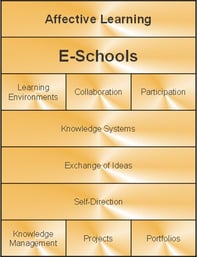Published on
LER Accelerator Inventory Yields Important Early Lessons

The Learning and Employment Records (LER) Accelerator Inventory is an important resource for understanding the fast-evolving landscape of LERs. LERs, which digitally capture an individual’s education, skills and work experiences, are key to connecting people to meaningful employment opportunities. The inventory, which the LER Accelerator coalition in partnership with the Learn & Work Ecosystem Library released in November 2024, offers insights into the many initiatives underway, the organizations driving the movement and the financial investments that fuel progress. The inventory maps relationships among organizations, initiatives and resources, offering a dynamic guide to the LER landscape.
The inventory serves multiple purposes for higher education institutions, workforce agencies and policymakers. It offers tools, resources and strategies for successful LER implementation and helps users navigate the complex terrain of digital credentials and employment records.
Four important lessons emerge from the inventory.
Lesson #1: Large-Scale Progress Requires Collaboration
Implementing a system as complex as LERs requires a coordinated effort among entities with diverse perspectives and expertise. An organization working alone won’t excel. Like a solo musician trying to play an orchestral score, it may produce sound, but it won’t create harmony.
Fortunately, a web of collaborative efforts is shaping the LER landscape. As described in the inventory, more than 30 organizations are heavily engaged in the movement. These include higher education institutions, professional associations, workforce development groups and tech companies. All play a pivotal role in shaping the development, verification and use of LERs.
By pooling resources and sharing insights, the LER Accelerator coalition and other groups are working to ensure that institutions, learners and employers benefit quickly and significantly from these innovations.
The LER Accelerator coalition is a major catalyst for change. It features twelve national organizations that stepped up in early 2024, forming a backbone for the LER movement. The coalition aids collaboration, shares best practices and guides institutions through the planning and adoption processes required in such a significant reform movement. By working together, coalition members ensure LERs can fit seamlessly into the nation’s interdependent systems of education, training and employment.
The coalition’s member organizations are:
- 1EdTech Consortium
- American Association of Community Colleges
- American Association of Collegiate Registrars and Admissions Officers
- American Association of Colleges and Universities
- American Council on Education
- Association for Institutional Research
- Competency-Based Education Network
- Digital Credentials Consortium
- EDUCAUSE
- National Academic Advising Association
- National Association of Colleges and Employers
- UPCEA
Lesson #2: There Is a Growing Vocabulary and a Need for a Shared Language
Terminology is vast and varied in the LER landscape. The inventory identifies 37 key terms that describe different components of the LER ecosystem, including:
- Alternative credentials
- Career-connected learning (CCL)
- Competency-based education (CBE)
- Digital identity wallet
- Learning passport
- Microcredentials
- Verifiable credential (VC)
- Web3 wallet (Crypto Wallet)
While this multiplicity of terms helps describe the nuances among different systems, it can also cause confusion. Multiple glossaries exist, and organizations often use overlapping terms, hindering communication. This complexity highlights the importance of developing a shared taxonomy—one of the coalition’s core aims. By promoting consistent language, the group hopes to make LER-related discussions more productive, helping stakeholders align on common goals.
Lesson #3: Initiatives Demonstrate Active Collaboration and Innovation
The inventory lists over 30 initiatives (special projects), many of which the LER Accelerator coalition leads. These initiatives aim to create standardized systems, foster credential transparency and empower learners to manage their own records.
Several states have launched projects to implement LERs or related learning verification records (e.g., learning wallets), often in collaboration with educational institutions and workforce development agencies. These include Alabama, Colorado, Connecticut, Indiana, Montana, New York, North Dakota and Tennessee. In many states, projects are in the pilot stage, at work in some institutions but not statewide.
The oldest projects date back to 2015 and focus on developing comprehensive learning records (CLRs) as part of the effort to redesign the traditional college transcript. Early CLR pilots were led by NASPA-Student Affairs Administrators in Higher Education and the American Association of Collegiate Registrars and Admissions Officers (AACRAO), working with institutions across the U.S.
The newest LER projects launched in 2024, some with timelines to extend work through 2027, depending on the duration of outside funding.
Several international efforts are underway, with multiple nations working together to build portable learning passports and interoperable data systems. The European Union, for example, is developing digital identity wallets, demonstrating the global relevance of these technologies. These types of cross-border collaborations demonstrate how LERs might reshape education and workforce systems worldwide.
And initiatives aren’t the only actors in the LERs landscape. The inventory categorizes a range of other efforts—nearly 90—most of which focus on communications, guidance and professional development:
- Communications documents—reports, briefs, white papers, research: 30 efforts (34% of the total)
- Guidance—frameworks, tools, guides, models, playbooks, action guides/plans: 28 efforts (32%)
- Professional development—events, webinars, courses, conferences: 20 efforts (23%)
- Web—webpages, digital resources, infographics: 7 efforts (8%)
- Work groups—networks, communities of practice, coalitions, collaborations: 3 efforts (3%)
Lesson #4: Targeted Financial Support Is Critical
Substantial government and philanthropic investments are fueling the rapid expansion of LERs. Leading foundations such as the Gates Foundation, Lumina Foundation, Strada Education Foundation and Walmart have provided millions of dollars in grants over several years to support LER planning, development and implementation. Federal and state government grants are also helping institutions pilot, test and scale LER projects.
This funding is crucial in enabling the technological infrastructure needed to test and scale LERs. For instance, blockchain technology, digital wallets and machine-readable credential systems require significant investment, but they are necessary to seamlessly share verified learning and work records. As the demand for skills-based hiring grows, so too will the funding for these systems.
Why the Inventory Matters to the Learn-and-Work Ecosystem
Publication of the LER Accelerator inventory marks a critical milestone in the LER landscape. The inventory provides a comprehensive overview of key initiatives, organizations and funding sources driving the LER movement. Think of the inventory as a compass, helping institutions and organizations navigate the complex terrain of digital credentialing and skills verification.
The four lessons learned so far suggest two things: (1) progress will not be easy and (2) more snapshots-in-time will be needed to assess progress.
As LERs continue to grow in use and importance, with support from advancements in technology, several steps will be crucial, among them streamlining the language, supporting collaborations of many types, ongoing investment in LER innovations and continued assessment of progress.
LERs clearly have the potential to revolutionize how learning and skills are verified for all learners and workers. In fact, they could well become the cornerstone for a more equitable and efficient education-to-employment pipeline.



